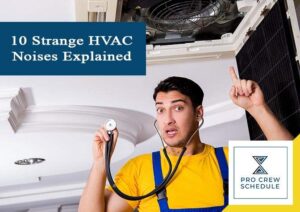The latest air conditioning units today are quieter than ever. Some technological innovations have made it possible to lessen the operation noise not to be an inconvenience for homeowners or other clients. However, in a few cases, abnormal and strange noises come up right from the HVAC systems. Since various complex parts are working together, it will be more likely difficult and tricky to diagnose the real issue. In fact, there can be a range of possible causes of why AC noises become prevailing.
In this article, we are about to discover the ten most common HVAC noises and sounds often dealt with by the HVAC experts.
HVAC Noise – Defining Volume
Before addressing why HVAC systems make noise, it is crucial to understand first the practical application of sound volume. All HVAC system manufacturers are posting the sound of the units. Most split and central A/C systems are purposely designed to maintain a lesser than 35-db sound level. For HVAC technicians like you, how do you define “db (decibel)”?
Read further below and consider the following relationships:
- 20-db – soft and low like the ticking of a watch
- 40-db – mild and quite distant like some echoes from a nearby park
- 60-db –clearly loud but sensibly subdued like friends conversing to one another
- 80-db – similar to TV commercials as it clangs for attention
- 100-db – demanding, alarming, and a complete distraction
Generally, the expected sounds from the client’s air conditioning system can be distant or mild, like echoes. It is crucial to distinguish the differences. Moreover, it is also equally important for HVAC techs to use project management tools to make inspections and the work, in general, easier and less complicated.
Common Noises Made by the HVAC System
Below are some of the common noises produced by the HVAC system.
1. Furnace Sounds
Unlike the duct sounds, you mustn’t take unexpected noise right from the furnace. Most sounds that came from the furnace serve as an indication that it needs attention. If a professional like you doesn’t bother to address this issue, it can be hazardous for everyone and the place itself. Unfortunately, furnaces can leak carbon dioxide into the client’s home.
- Squealing or Whistling
Squealing can often be attributed to the blowers or heat pump. This sound might mean that there is a belt that is being frayed. On the other hand, the blower and its housing box need some cleaning. Whistling often happens when something hinders proper airflow. It is caused by an uncleaned air filter or closed vents and dumpers. HVAC technicians have to change the filters or replace the furnace to solve the noise immediately if necessary.
- Knocking and Rumbling
Knocking is usually a benign noise. It also commonly indicates that the vibration damper is not installed correctly. As a result, the sounds coming from the blower reverberate throughout the system. Huffing, puffing, or rattling sounds are considered more problematic.
Take note that furnace rumbling is a sign of burner issues. Hence, it should be given attention as it can possibly produce a higher level of carbon monoxide.
- Loud bang
There is an issue with the ignition, and it results to furnace banging. Ignition issues signify that there is a build-up of gas in the combustion chamber. Other causes include the expansion and contraction of the ductwork. Skilled HVAC technicians should immediately fix any issues found in the ignition.
2. Duct Noises
The ductwork system is commonly made up of sheet metal within a network of pipes, dampers, and valves. Hearing air existing vents in the rooms is common, but it can be quite alarming if there’s lesser ordinary sounds. HVAC technicians are required to inspect the attic and to walk through support joints. Any loose components can be strongly tightened using duct screws and HVAC tapes if possible.
Inspections are well-performed using construction scheduling software. Make sure to use this advanced software application as it offers various project management features. On top of that, it is easy to understand, to use and to access.
- Popping and Rattling
For instance, rattling and banging result when there are changes in the temperature and when duct walls contract and expand in response. Rattling often occurs when loose metal pipes hit against each other. As the system ages, the sealant is not as effective as it is before. Also, the static pressure can cause ducts to lose. During the inspection, if you found clogged filters that are blocking airflow, you can assume a pressure drop that might cause vibrating and shaking ducts.
- Buzzing
Scratching and buzzing in the ducts might be caused by bees, raccoons, squirrels or mice. These insects and animals have somehow found a way to enter in the ductwork. A thorough inspection is necessary as it will determine if there’s an intruder or not.
- Booming
Booming sounds are common when the ductwork attaches to the plenum – the air distribution box that is facilitating the air circulation. It is the very spot where the most significant temperature swing occurs. Hence, there might not be sufficient expansion joints or dampers to isolate the ground.
- Hissing
Hissing sounds coming from the HVAC system are often rare. If there’s a hissing sound, it might indicate a very serious problem. There might be a catastrophic refrigerant leak that was being dumped directly into the atmosphere. Only skilled HVAC techs and a subcontractor can fix such issues by performing refrigerant line replacements.
- Bubbling
A bubbling noise is usually stemming from a slow leak where gas bubbles are produced into the refrigerant line. Performing repair and leak detection as soon as possible is the easy way to fix it to avoid further damage. Make sure to perform a detailed inspection before and after to check everything.
3. Air-conditioning sounds
Most of the AC units today are quieter than ever. The units are often equipped with two-speed compressors and sound-dampening technology that keep the noise level under 50 decibels. If odd sounds are coming from the AC systems, you have to pay better attention. It often indicates the need for tune-ups. However, it can be a massive issue since noises coming from ACs can take various forms.
In most cases, AC noises are due to loose components like bolts, loosening compressors or twigs that might get into the unit by accident. The noises produced by the loose components are commonly lower-pitched and might produce the following sounds below.
- Squealing
Squealing indicates some possible issues with the fan motors or blower motors. Buzzing often denotes a range of issues like unbalanced fan blades, failing outdoor motors, a condenser coil that needs refrigerant leaks and cleaning.
- Screaming
Screaming sound is probably the most serious sound that any AC unit can make. If that occurs, it is a cue to shut the system down immediately. HVAC technicians, hearing a loud, high-pitched screaming and whistling sound from the AC, only means a highly-damaging refrigerant leak. This type of issue often affects the health of occupants.
What HVAC Technicians Typically Do?
HVAC technicians immediately offer assistance to their clients, including HVAC servicing, which often happens annually. This HVAC service is imperative to lubricate the system as needed and to replace worn-out parts. Generally speaking, it is to ensure that all system components continue to function as they should.
And before getting into the ins and outs of noise levels and ductworks, noise reduction basics should be considered. Now, let’s discover some basic responsibilities of HVAC techs when dealing the noise issues:
- Closing several dampers at once will make the system much noisier. However, if to close one damper, it will not make much difference.
- The bends and sags can make it difficult for the system to move air. As a result, it creates noise and increases static pressure. HVAC techs have to make sure to check all ductworks and see if it is properly installed. If the ductwork is not properly installed, it may bend and sag.
- Making sure to close the supply vents to undue stress on the HVAC system.
- Using project management software to make the work easier, faster and efficient.
- Over time, dirt and dust build-up will take over in the air filters, making the system much noisier. The only solution for this is to replace and thoroughly clean the filter on a regular basis.
- Cleaning the ducts quickly as it starts to impede airflow.
- Adjusting the fan speeds since the furnace fan and blower are set to deliver the airflow per ton.
- HVAC techs start configuring the process properly during installation.
- Selecting a lower fan speed often lessens static pressure as well as air noise.
- Minimizing the speed when the HVAC system was properly set-up.
- Sizing the equipment properly like ductworks, fans or blowers.
- Increasing ductwork to make the system much quieter. Note, it decreases static pressure.
- Adding a bypass duct that will relieve pressure and reduce noise within the system.
- Expanding registers and grilles if there’s no sufficient return air.
- Increasing the size of the current grilles is one effective way to reduce static pressure.
- Interchanging the size of existing supply registers.
- Implementing construction crew management to well-supervised the teams and subcontractors.
Key Takeaways
While most of your clients can do some minor fixes in any noise issues, it is sometimes not always the case. There are many instances that the rising issues are too complex to handle, and it immediately requires professional HVAC assistance. That is why any HVAC professionals must know every occurring noise issue, the primary cause behind it, and how to fix it properly.







